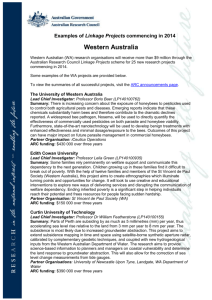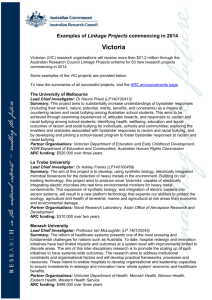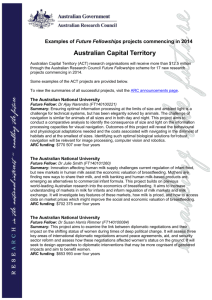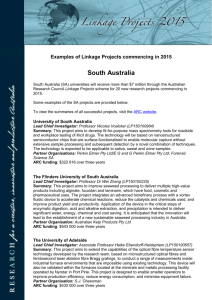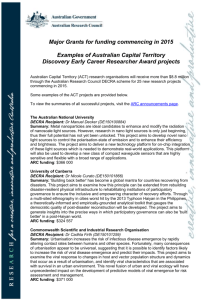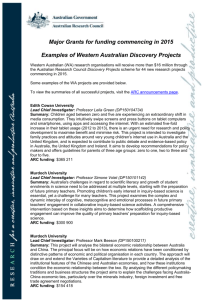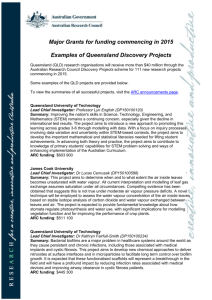Word Format - Australian Research Council
advertisement
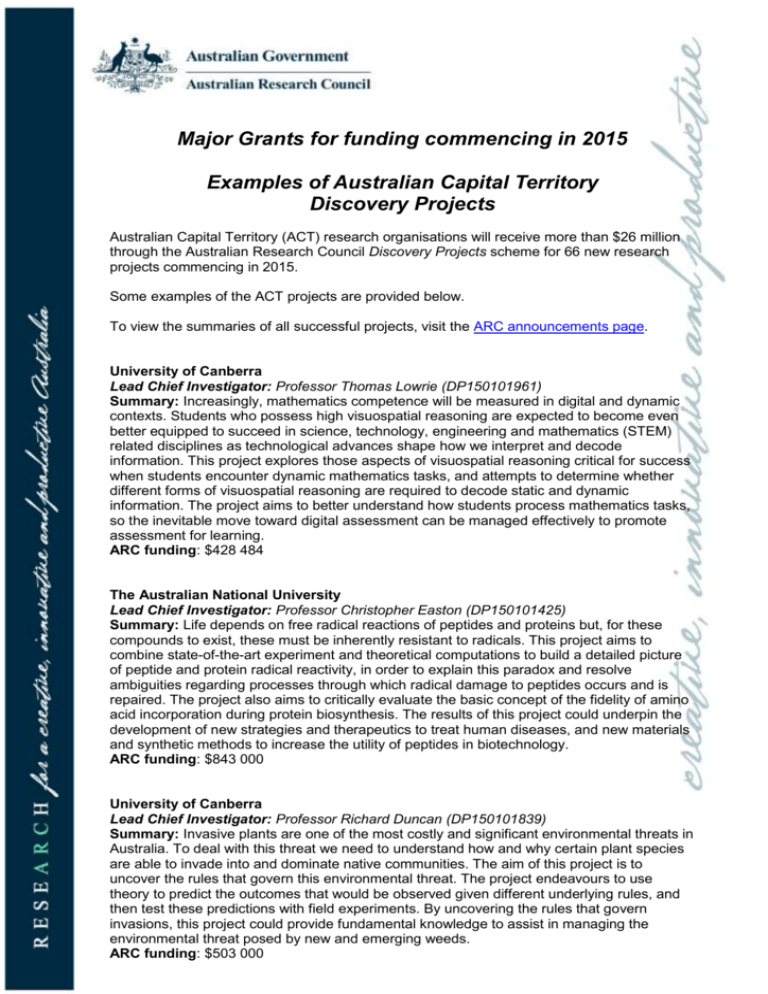
Major Grants for funding commencing in 2015 Examples of Australian Capital Territory Discovery Projects Australian Capital Territory (ACT) research organisations will receive more than $26 million through the Australian Research Council Discovery Projects scheme for 66 new research projects commencing in 2015. Some examples of the ACT projects are provided below. To view the summaries of all successful projects, visit the ARC announcements page. University of Canberra Lead Chief Investigator: Professor Thomas Lowrie (DP150101961) Summary: Increasingly, mathematics competence will be measured in digital and dynamic contexts. Students who possess high visuospatial reasoning are expected to become even better equipped to succeed in science, technology, engineering and mathematics (STEM) related disciplines as technological advances shape how we interpret and decode information. This project explores those aspects of visuospatial reasoning critical for success when students encounter dynamic mathematics tasks, and attempts to determine whether different forms of visuospatial reasoning are required to decode static and dynamic information. The project aims to better understand how students process mathematics tasks, so the inevitable move toward digital assessment can be managed effectively to promote assessment for learning. ARC funding: $428 484 The Australian National University Lead Chief Investigator: Professor Christopher Easton (DP150101425) Summary: Life depends on free radical reactions of peptides and proteins but, for these compounds to exist, these must be inherently resistant to radicals. This project aims to combine state-of-the-art experiment and theoretical computations to build a detailed picture of peptide and protein radical reactivity, in order to explain this paradox and resolve ambiguities regarding processes through which radical damage to peptides occurs and is repaired. The project also aims to critically evaluate the basic concept of the fidelity of amino acid incorporation during protein biosynthesis. The results of this project could underpin the development of new strategies and therapeutics to treat human diseases, and new materials and synthetic methods to increase the utility of peptides in biotechnology. ARC funding: $843 000 University of Canberra Lead Chief Investigator: Professor Richard Duncan (DP150101839) Summary: Invasive plants are one of the most costly and significant environmental threats in Australia. To deal with this threat we need to understand how and why certain plant species are able to invade into and dominate native communities. The aim of this project is to uncover the rules that govern this environmental threat. The project endeavours to use theory to predict the outcomes that would be observed given different underlying rules, and then test these predictions with field experiments. By uncovering the rules that govern invasions, this project could provide fundamental knowledge to assist in managing the environmental threat posed by new and emerging weeds. ARC funding: $503 000 The Australian National University Lead Chief Investigator: Professor Michelle Coote (DP150104454) Summary: Radical polymerisation is the most commercially important polymer process, favoured by industry for its broad scope and relatively low cost and environmental impact. However, its use in the synthesis of 'smart materials' for biomedical applications, molecular electronics and high-performance engineering applications has been hampered by the lack of microstructural control. This project aims to use a complementary combination of theory and experiment to develop novel structured Lewis acids for controlling the stereochemistry in freeradical polymerisation, and to utilise the recently discovered propagation catalysis conferred by simple Lewis acids to minimise defect structures and thereby improve the thermal and photostability of polymers. ARC funding: $409 900 The Australian National University Lead Chief Investigator: Associate Professor Aaron Corn (DP150104389) Summary: The Aboriginal Artists Agency (AAA) was a driving force for change in the Australian arts industry. Founded in 1976, it was the first national body to administer copyrights for indigenous artists, create international demand for Australian culture and pioneer ways for Indigenous artists to reach audiences and markets worldwide. This project aims to investigate the seminal work of the AAA, secure and analyse its exclusive primary collection and assess the vast corporate knowledge of its personnel through new interviews. New frameworks for assessing Indigenous arts initiatives, it is hoped, will be generated through this unprecedented analysis of the AAA's role in reshaping attitudes towards Australian identities. ARC funding: $481 766 The Australian National University Lead Chief Investigator: Dr Dougald O'Reilly (DP150101164) Summary: Since their discovery in the 1930s, the mysterious collections of giant stone jars scattered throughout central Laos have remained one of the great prehistoric puzzles of south-east (SE) Asia. It is thought that the jars represent the mortuary remains of an extensive and powerful Iron Age culture. This project seeks to determine the true nature of these sites, which date to a dynamic period of increasing complexity in SE Asia (c.500BCE500CE). The project entails extensive reconnaissance, precision mapping, archaeological excavation and analysis of associated burial material. Using a suite of cutting-edge archaeological technologies, it is expected to have far-reaching benefits for archaeology, science, Laos and World Heritage. ARC funding: $425 100 The Australian National University Lead Chief Investigator: Dr Philip Gibbons (DP150100878) Summary: The number of houses destroyed by bushfires in Australia is increasing. This project aims to undertake the first comprehensive analysis of links between land management practices and house loss during bushfires across Australia. Results from this research are expected to improve the ability of authorities, industry and individual home owners to quantify risk from bushfires, and to identify ways that Australian landscapes can be managed to reduce house losses during bushfires. Results from this research will be communicated directly to key stakeholders including government agencies, industry and home owners. ARC funding: $217 500 The Australian National University Lead Chief Investigator: Professor Martin Asplund (DP150100250) Summary: By developing state-of-the-art stellar atmosphere and evolution models, the project will endeavour to answer some of the key outstanding questions in stellar astrophysics including how magnetic fields are manifested in stars, how stars are affected by convection, how oscillations are excited in stars and how old the most ancient stars in the Milky Way are. The project will endeavour to make obsolete the free parameters that have hampered stellar modelling for the past half-century. Using unique stellar models the project aims to provide rich legacy resources for countless studies in modern astronomy and provide the necessary theoretical underpinning for ambitious Australian-led Milky Way surveys, such as GALAH and SkyMapper, and international satellite missions such as Kepler, TESS and PLATO. ARC funding: $385 100 The Australian National University Lead Chief Investigator: Professor Elinor McKone (DP150100684) Summary: Low-resolution face images occur in several settings that require a human observer to identify the face or its expression. For example, a crime eyewitness may have seen the perpetrator's face blurred by distance. This project aims to improve low-resolution face perception. Previous approaches have attempted only to improve general image visibility. Here, the novel theoretical idea is to alter the face's structure, tapping knowledge about higher-level face coding. Manipulations are caricaturing and whole-then-part alternation, as derived from face-space and holistic processing theories, respectively. Effects of viewpoint and own-versus-other race faces are expected to test practical generalisability of the new methods, and thus refine theory. ARC funding: $518 500

